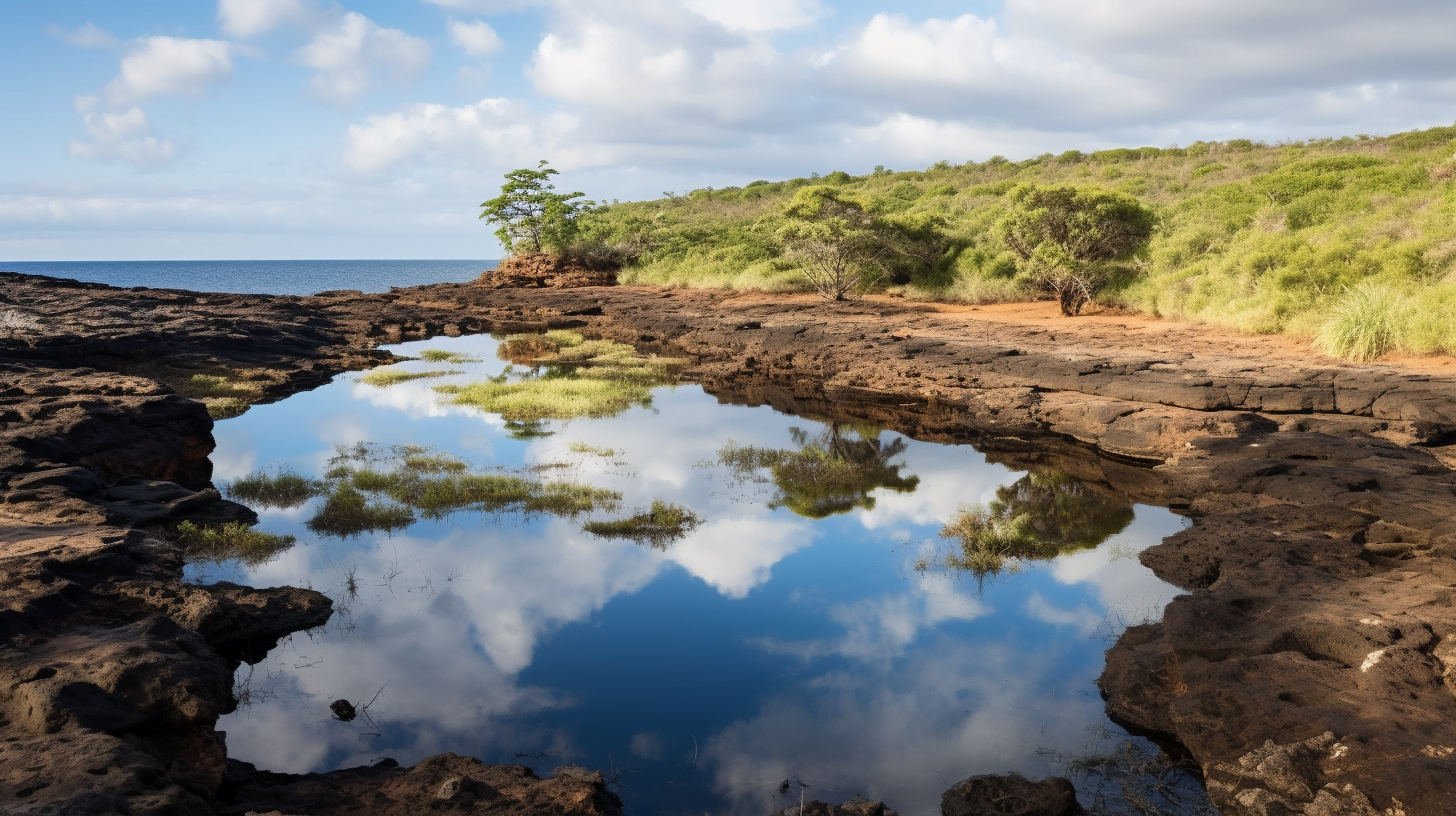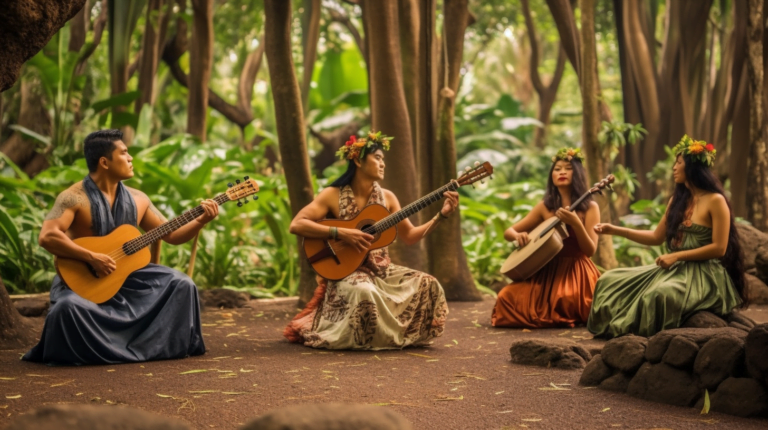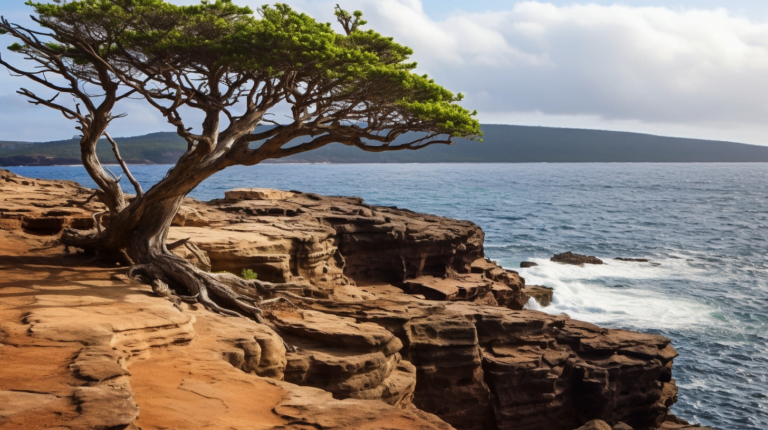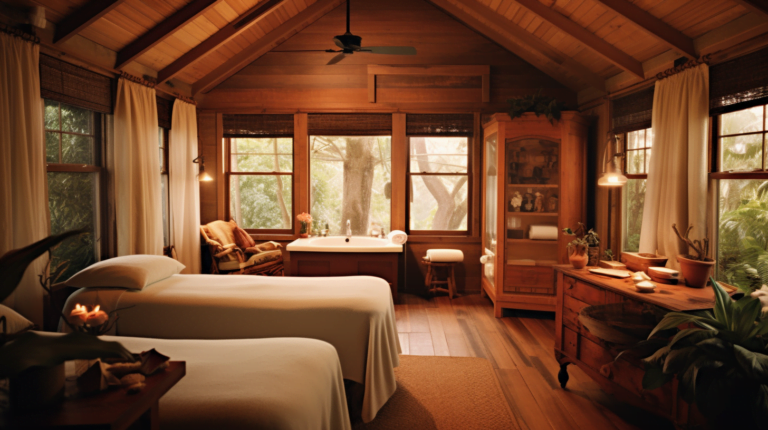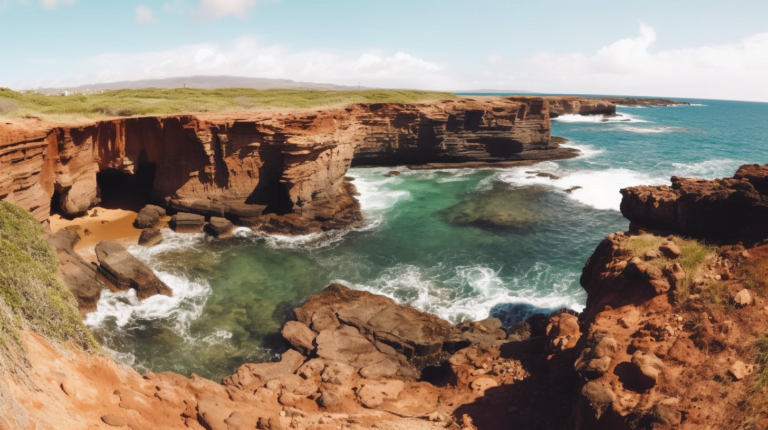🌺 Discovering Lanai: A Conservationist’s Guide to Paradise in Hawaii 🌿
Imagine stepping into a living, breathing painting, where the colors are more vibrant, the scents more fragrant, and the sounds more harmonious than anything you’ve ever experienced. This is the paradise that awaits you on Lanai, a secluded island in Hawaii that is home to some of the world’s most breathtaking natural wonders.
As a conservationist, you already understand the importance of preserving our planet’s biodiversity. Lanai is a veritable treasure trove of rare species and ecosystems, and you are about to embark on a journey of discovery that will leave you awestruck and inspired.
Lanai’s natural beauty is not just a sight to behold, but a reminder of the delicate balance that exists between humans and the environment. The island’s wildlife and plant life have survived for centuries in relative isolation, and it is only in recent years that they have faced new threats from climate change, habitat loss, and human activity. But thanks to the tireless efforts of conservationists and local communities, Lanai’s natural wonders are still thriving, and you have the opportunity to witness them firsthand and contribute to their preservation.
So grab your hiking boots, binoculars, and snorkel gear, and get ready to immerse yourself in Lanai’s pristine landscapes and fascinating wildlife.
Key Takeaways
- Lanai Island is home to many endangered species and has several designated areas as critical habitats.
- Conservation efforts on Lanai are focused on restoring and protecting the island’s native forests, water resources, and native plant and animal species.
- Sustainable tourism practices can contribute to the preservation of Lanai’s unique ecosystem, and visitors can minimize their impact on the environment by staying at eco-friendly accommodations and practicing responsible snorkeling and diving.
- Lanai’s history and culture are deeply intertwined with its natural environment, and the Lanai Culture and Heritage Center provides visitors with a deeper understanding of the island’s cultural and natural history.
Introduction to Lanai and Its Natural Beauty
You’re in for a treat as you discover Lanai’s breathtaking natural beauty firsthand. This small Hawaiian island is home to pristine beaches, rugged landscapes, and unique flora and fauna that make it a nature lover’s paradise. While Lanai may be small in size, it is big on natural wonders, and a visit to this island will leave you feeling awe-inspired and rejuvenated.
Lanai’s history and culture are deeply intertwined with its natural environment. The island’s ancient Hawaiian name, Lānaʻi, means ‘day of conquest’ or ‘victory day,’ and it was considered a sacred place by the native Hawaiians. Over the years, Lanai has been home to ranching and pineapple plantations, but today, its natural beauty is the main attraction.
The island’s rugged terrain, lush forests, and pristine beaches offer a glimpse into the island’s rich history and cultural heritage. The best time to visit Lanai for nature lovers is between May and September, when the weather is warm and dry. During this time, you can explore the island’s many hiking trails, snorkel in its crystal-clear waters, and spot some of its unique wildlife.
Whether you’re looking to relax on the beach or get your adrenaline pumping with an outdoor adventure, Lanai has something to offer everyone. As you explore Lanai’s natural wonders, you’ll quickly realize that the island is home to many endangered species. In the next section, we’ll take a closer look at these animals and the conservation efforts underway to protect them. But first, let’s dive deeper into Lanai’s natural beauty and all it has to offer.
Lanai’s Endangered Species and Their Conservation
If you’re lucky, you might catch a glimpse of the endangered Lanai Hookbill while exploring the island. This species of bird is endemic to the island and is unique to the area. Unfortunately, like many other species on Lanai, the Lanai Hookbill is threatened by habitat loss and invasive species. Lanai’s conservation challenges include protecting these endangered species and their habitats.
To address these issues, various conservation measures have been put in place. For instance, the Lanai Forest and Watershed Partnership (LFWP) has been working to remove invasive species and restore native habitats. The LFWP has also been conducting surveys to monitor the populations of endangered species like the Lanai Hookbill. Additionally, the state of Hawaii has designated several areas on Lanai as critical habitat for endangered species, further protecting them from harm.
Despite these efforts, more work needs to be done to safeguard the island’s unique wildlife. Lanai’s conservation challenges are ongoing, and it is crucial that visitors to the island respect the efforts being made to protect its natural beauty. By staying on designated trails and avoiding disturbing wildlife, visitors can help ensure that endangered species like the Lanai Hookbill continue to thrive on the island.
As you explore Lanai’s natural beauty, keep in mind the importance of protecting its unique wildlife. Next, we’ll explore some of the best hiking trails in Lanai’s nature preserves, where you can experience the island’s natural wonders up close.
Hiking Trails in Lanai’s Nature Preserves
As you wander along the rugged trails, your feet sinking into the soft earth, you’ll stumble upon breathtaking views of Lanai’s untouched wilderness. The hiking trails in Lanai’s nature preserves offer a unique opportunity to explore the island’s diverse flora and fauna.
These trails vary in difficulty, from easy walks to challenging hikes that require proper gear. For the easy trails, you can wear comfortable shoes with good traction and bring a water bottle to stay hydrated. Some of the more challenging hikes may require hiking boots, sunscreen, and a hat to protect you from the sun. It’s essential to plan ahead and know the difficulty of the trail before setting out.
Exploring Lanai’s nature preserves on foot is an incredible way to connect with nature and enjoy the island’s beauty. The trails offer a chance to observe rare plants and animals, such as the endangered Lanai Hookbill and the Hawaiian Petrel.
Next, let’s explore the forests of Lanai and discover the best spots for birdwatching.
Birdwatching in Lanai’s Forests
If you’re a birdwatching enthusiast, you won’t want to miss the chance to explore Lanai’s stunning forests.
The Kanepuu Preserve is a must-visit destination. Here, you can spot a variety of native and endemic birds, such as the Hawaiian owl and the iiwi.
Another great spot to visit is Keahiakawelo, also known as the Garden of the Gods. This spot offers breathtaking views and the opportunity to spot rare bird species like the Hawaiian petrel.
Kanepuu Preserve
Explore Kanepuu Preserve and discover the diverse range of flora and fauna that inhabit this pristine wilderness. This nature preserve boasts a unique collection of endemic flora, including plants that can only be found on Lanai. The preserve is also home to several endangered species, such as the Hawaiian petrel and the Lanai tree snail.
Despite its beauty, Kanepuu Preserve faces conservation challenges due to invasive species and habitat destruction. However, conservationists have helped to protect this valuable ecosystem. As you hike through the preserve, take in the stunning scenery and appreciate the hard work that goes into preserving this natural wonder.
Now, let’s move on to the next section and discover the breathtaking beauty of keahiakawelo (garden of the gods).
Keahiakawelo (Garden of the Gods)
Get ready to be amazed by the otherworldly landscape of Keahiakawelo, where towering rock formations and vibrant red earth create a visual feast for your eyes. This natural wonder, also known as the Garden of the Gods, is a popular destination for hikers and nature lovers on Lanai.
The rock formations found in Keahiakawelo are a result of centuries of erosion and weathering, creating unique shapes and textures that are truly one-of-a-kind. Aside from its natural beauty, Keahiakawelo holds great cultural significance to the people of Lanai.
Legend has it that the area was once a sacred garden tended to by ancient Hawaiian gods, and the rocks are said to be the remnants of a great battle between gods and giants. As you explore this mystical place, take a moment to appreciate the rich culture and history that surrounds you.
As you leave Keahiakawelo and head towards Lanai’s waters, you’ll be greeted by an entirely different world of wonder and amazement. Discover the diverse marine life that call Lanai’s waters home, including dolphins, sea turtles, and colorful fish.
Marine Life Encounters in Lanai’s Waters
Spotting dolphins and sea turtles is a common occurrence while snorkeling or diving in Lanai’s pristine waters. The island boasts some of the best snorkeling spots in the world, such as Hulopoe Bay, Manele Bay, and Shark Fin Cove. These areas are teeming with marine life, including colorful tropical fish, manta rays, and even the occasional hammerhead shark.
If you’re lucky, you might also catch a glimpse of the elusive monk seal, one of the rarest marine mammals in the world. For those interested in larger marine life, Lanai offers whale watching tours during the winter months when humpback whales migrate to the warm waters of Hawaii. The tours depart from Manele Harbor and offer a chance to see these majestic creatures up close.
It’s an unforgettable experience to hear the whales’ songs echoing through the water and to witness their playful behavior as they breach and slap their fins on the surface. As you explore the waters of Lanai, it’s important to remember to be respectful of the marine environment. Avoid touching or chasing marine life, and never feed them.
By practicing responsible snorkeling and diving, we can help preserve the rich marine ecosystem of Lanai for future generations to enjoy. Speaking of preservation, let’s now shift our focus to the rare plants and their conservation efforts on the island.
Rare Plants and Their Conservation
If you’re curious about Lanai’s unique flora, you’ll be interested to know that the island is home to several endangered plant species, including the Lanai sandalwood and the Munroidendron racemosum, which are both in danger of extinction. The island’s fragile ecosystem is threatened by human activity, such as invasive species, overgrazing, and development. However, there are conservation strategies in place to protect these endangered habitats.
The Lanai Forest and Watershed Partnership works to restore and protect the island’s native forests, which are home to many endangered plant species. They do this by removing invasive species, planting native plants, and conducting research on the island’s ecosystem.
The Munroidendron racemosum is a critically endangered plant that only grows on Lanai. The Munroidendron Recovery Project, a partnership between the State of Hawaii and the Lanai Native Species Recovery Program, is working to protect this rare plant. They have established a seed bank and are researching ways to propagate the plant.
The Lanai Cultural and Heritage Center is working to preserve the island’s cultural heritage, which includes traditional knowledge of the island’s plants and their uses. By preserving this knowledge, they hope to prevent the loss of traditional practices that can help protect Lanai’s unique ecosystem.
The Lanai Native Species Recovery Program works to protect and restore Lanai’s native plant and animal species. They conduct research on the island’s ecosystem and work with local communities to promote conservation efforts.
As you can see, there are many conservation strategies in place to protect Lanai’s endangered plant species and their habitats. These efforts are crucial to preserving the island’s unique ecosystem. In the next section, we’ll explore how sustainable tourism and conservation efforts on Lanai can work hand in hand to protect this fragile ecosystem.
Sustainable Tourism and Conservation Efforts on Lanai
By promoting sustainable tourism practices, visitors can experience the beauty of Lanai while also contributing to the preservation of the island’s unique ecosystem.
Lanai is home to several nature preserves and wildlife that have been conserved through the efforts of the local community. These efforts include the establishment of eco-friendly accommodations, which promote sustainable tourism practices that are beneficial to both the environment and the local economy.
The community involvement in conservation efforts on Lanai has been vital to the success of preserving the island’s natural resources. The Lanai Culture and Heritage Center provides visitors with a deeper understanding of the island’s cultural and natural history, while the Lanai Watershed Partnership works to protect the island’s water resources. These efforts have helped to maintain the island’s biodiversity, which supports a variety of unique plant and animal species.
The eco-friendly accommodations on Lanai offer visitors an opportunity to experience the island’s natural beauty while minimizing their impact on the environment. These accommodations include the Four Seasons Resort Lanai, which uses renewable energy sources and implements sustainable practices throughout the resort.
By choosing to stay at eco-friendly accommodations, visitors can contribute to the preservation of the island’s ecosystem and support the local community’s efforts to promote sustainable tourism practices.
Conclusion
Congratulations on exploring the natural wonders of Lanai! As a conservationist, you understand the importance of preserving the island’s unique ecosystems and protecting its endangered species. Your efforts to support sustainable tourism and conservation efforts on the island are greatly appreciated.
By hiking through Lanai’s nature preserves, birdwatching in its forests, and encountering marine life in its waters, you’ve gained a deeper appreciation for the island’s natural beauty. You’ve witnessed rare plants and animals in their natural habitats and learned about conservation efforts to protect them.
As the poet Robert Frost once said, “Nature’s first green is gold, her hardest hue to hold.” Your journey to Lanai has reminded you of the fragility and beauty of nature and the importance of protecting it for future generations.
Keep up the good work and continue to spread awareness about the importance of conservation efforts in Lanai and beyond.

